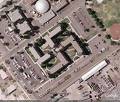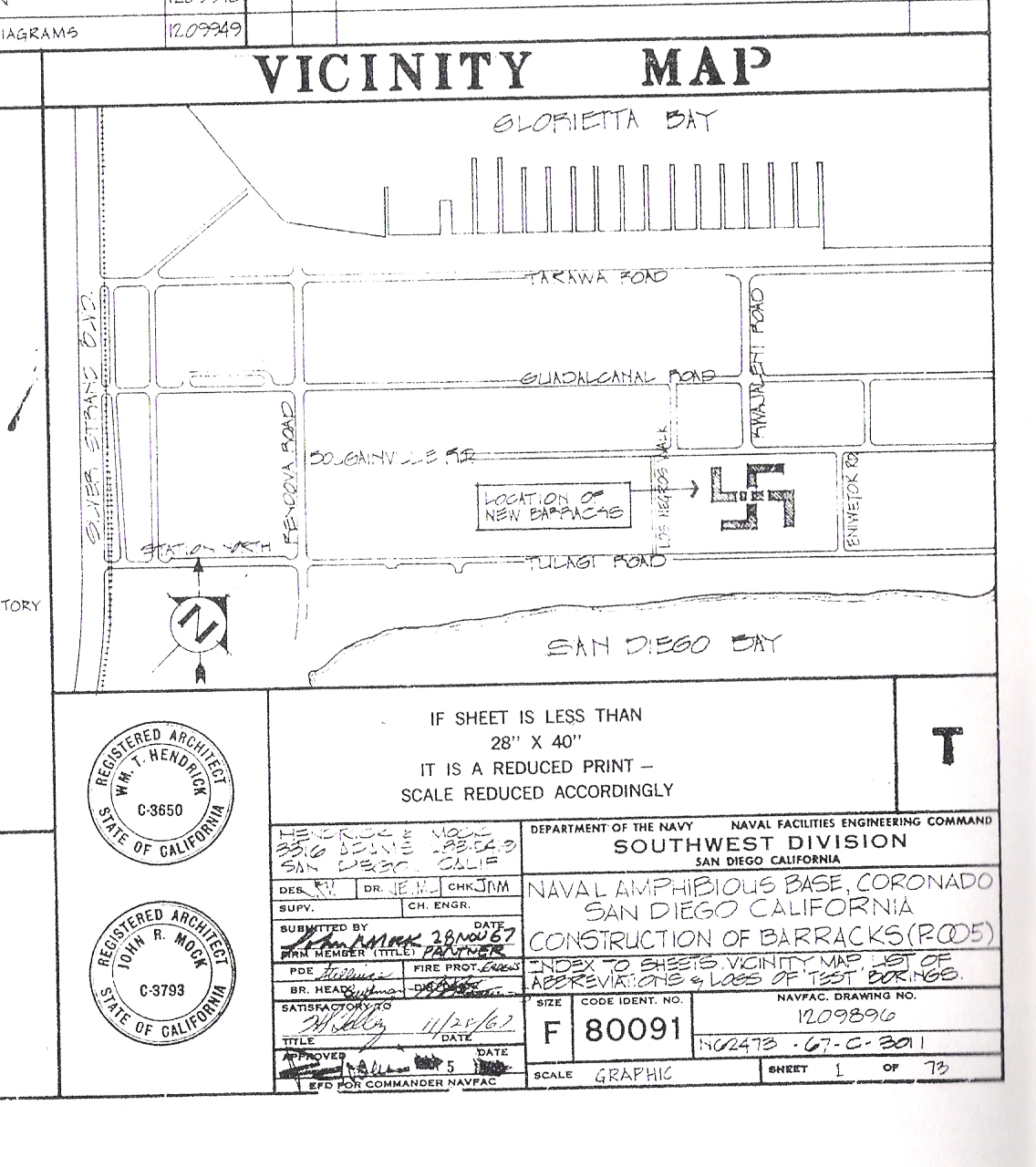By Donald H. Harrison
SAN DIEGO, Calif —The swastika-shaped barracks complex at the Naval Amphibious Base in Coronado has stood for 36
years, so this is not a new story. However,
satellite imaging and Google recently have put it on display to an astonished
world. As of
December 7, 2006, which coincidentally was Pearl Harbor Day,
someone typing the words “Coronado Swastika” into Google’s
Internet finder would be directed to 21,400 sites.
Word is spreading throughout the world how a Nazi symbol stares up from
a United States military base.
via www.thepowerhour.com
 If
you surf the sites, you will see a variety of reactions.
Some people are outraged, as well they should be.
Not everybody, of course All
those neo-Nazi organizations out there are delighted.
If
you surf the sites, you will see a variety of reactions.
Some people are outraged, as well they should be.
Not everybody, of course All
those neo-Nazi organizations out there are delighted.
World War II cost the lives of
318,274 U.S. service personnel—182,070 of them in the European theatre.
These brave soldiers and sailors died fighting
the people whose symbol inexplicably mocks their deaths from the grounds of a
U.S. Naval Base.
In response to the explosion of interest about the four L-shaped buildings
configured into a swastika around two smaller central buildings, U.S.
Congresswoman Susan Davis (D-San Diego) and Morris Casuto, regional director
of the Anti-Defamation League, contacted Navy brass to find out what can be
done about the offensive symbol.
 The
Naval Amphibious Base is within Davis’s district.
Her interest runs even deeper than that:
She is an active member of our Jewish community, and she is also a
member of the House Armed Services Committee. "I
have been in contact with the Navy on the matter of the barracks in
Coronado,” she told the Jewish Times in an e-mail message sent on December
5. “I am supportive of their efforts to find a feasible solution.”
The
Naval Amphibious Base is within Davis’s district.
Her interest runs even deeper than that:
She is an active member of our Jewish community, and she is also a
member of the House Armed Services Committee. "I
have been in contact with the Navy on the matter of the barracks in
Coronado,” she told the Jewish Times in an e-mail message sent on December
5. “I am supportive of their efforts to find a feasible solution.”
Casuto told the Jewish Times that he also spoke recently about the
barracks with U.S. Navy Capt. Mike Allen, who is chief of staff to Rear
Admiral Len Hering at Naval District Southwest, the command which has
administrative jurisdiction over a plethora of bases in San Diego County,
including the Naval Amphibious Base in Coronado.
The ADL Director said he told the Navy that he was concerned that the swastika
buildings send a terrible message. The symbol tears a hole in the hearts of
Jews everywhere, and especially in the hearts of our Holocaust Survivor
community. Casuto said he asked
if the configuration of the buildings could be changed so that the hated
symbol does not become Coronado’s most recognized landmark, even better
known than the Hotel del Coronado. Casuto
reported that Allen told him he would see what could be done.
In a subsequent conversation with San Diego Jewish Times, Allen
confirmed that the Navy will look anew into whether the buildings can be
modified. He said that as the
four-story concrete buildings are
home to about 1,000 service personnel, they are too valuable to be simply torn
down. He was of the impression
that on several occasions over the last 36 years,
the Navy, without success, has tried to change the appearance of the
buildings from the air by adding hardscape features, like pavement, and
landscape features, like trees—but to no avail.
Through most of the last three and a half decades, very few people even would
have seen the swastika design of the barracks – perhaps only those
passengers who looked at just the right time out a left-side window of a plane
approaching Lindbergh Field. But now, as a result of Google and the satellite
imaging, it’s time for the Navy to consider again how the buildings might be
modified, Allen said.
I’m just guessing but there probably are
numerous ways that the swastika configuration of the flat-roofed,
33,034-square-foot building complex can be changed.
Extensions, whether full-scale building additions or simple walkways,
might connect the arms of the four L’s, creating a square.
Another option: If you have ever driven by the old Convair plant near
Lindbergh Field you can see the repetitive small triangular structures sitting
on the roof of the long building where warplanes were once manufactured. Those were put there as camouflage, in case an enemy plane
should ever fly over. From the sky
those boxes would have looked like the roofs of houses.
An enemy bombadier, looking down, would have seen a little village
instead of an aircraft plant. Conceivably,
the rooflines of the swastika complex could be broken up in similar fashion.
These are not the only options, of course.
Any architects among this newspaper’s readership probably could
sketch a dozen more.
There are two important questions attendant to this controversy.
The first is now that the issue is again on the front burner, what can
or will be done to get rid of the swastika?
The second is how in the hell did a swastika design ever get
there in the first place?
On this latter question, Allen says he is totally mystified.
An illustration accompanying this article shows a vicinity map
submitted in November 1967 by architects William T. Hendrick and John R. Mock
that clearly shows the swastika configuration. Allen says he has trouble
imagining why someone at the time didn’t notice the offensive symbol and
seek a redesign.
Mock, in an interview with KFMB-TV, said, no matter what the complex looks
like from the air, “it isn’t that—it is four L-shaped buildings.
When you look at the ground and you look at the air; it still is.”
He told reporter Steve Price that the design was efficient, maximized
space and won architectural awards.
On a website for the Coronado Amphibious Base, the Navy admits that there was
an “oversight” by Navy planners in the design and construction of the
complex, officially called “NAB Complex 320-325.”
According to the site (as it appeared on December 7, 2006): “It
wasn’t until after the groundbreaking began that Navy officials realized how
the buildings would appear when seen from above.”
We asked for amplification from Steve Fiebing, a civilian public affairs
officer at Naval Base Coronado—of which Naval Amphibious Base in a
component. He said that the snafu
was that the design of the first L-shaped building was approved by the Navy
without anyone thinking about what happens when four L-shaped buildings are
configured together. Fiebing said it is his understanding that the Vicinity Map
accompanying this article was drawn well after the project was too far along
in the process to be changed.
Getting approval for buildings to be constructed is a long and laborious
project—involving votes in Congress—and, even though it was eventually
realized they would have a swastika on their base, some Navy brass somewhere
decided not to hold up the construction.
The new Vietnam War-time housing was deemed essential.
The officially approved website, as of December 7, 2006, went on to say:
“The Navy has fully utilized this building complex for more than 35 years,
and intends to continue the use of the buildings, as long as they remain
adequate for the needs of the service.”
* * *
One reason that the story of the swastika complex is being addressed again is
because of the persistence of Avrahaum
Segol, a Wisconsin-raised Israel resident who holds dual U.S.-Israel
citizenship. Segol is a musician, a clothes designer for observant Jewish
males, and a researcher who is working on a book that inquires into the
origins of controversial symbols on public property in the United States.
Besides the swastika on the Amphibious Base, Segol has been researching the
Mount Soledad Cross controversy, and has been inquiring about the frieze on
the south wall inside the United States Supreme Court that shows Moses holding
one of the two tablets bearing the Ten Commandments.
According to Segol, Moses’ beard falls in front of the tablets in such a way
that the Hebrew word “Lo” (typically translated “Thou Shalt Not”) is
missing from each of the commandments proscribing murder, adultery, stealing,
perjury and coveting. To a Hebrew
reader, the frieze could appear as if Moses is advocating these sins.
That may be a story for another time. But
in the meantime, I’d like to applaud Segol’s dogged efforts to get to the
bottom of the swastika story. He
was the one, for example, who obtained the Vicinity Map, and passed it on to
the Jewish Times, and it was he who has been in touch with numerous San
Diego journalists, including Steve Price, who covered this issue on KFMB-TV.
So, to Avrahaum Segon, a yasher koach. We'll be interested to
read the outcome of your investigations into these controversial symbols and
others under your investigative scrutiny.

